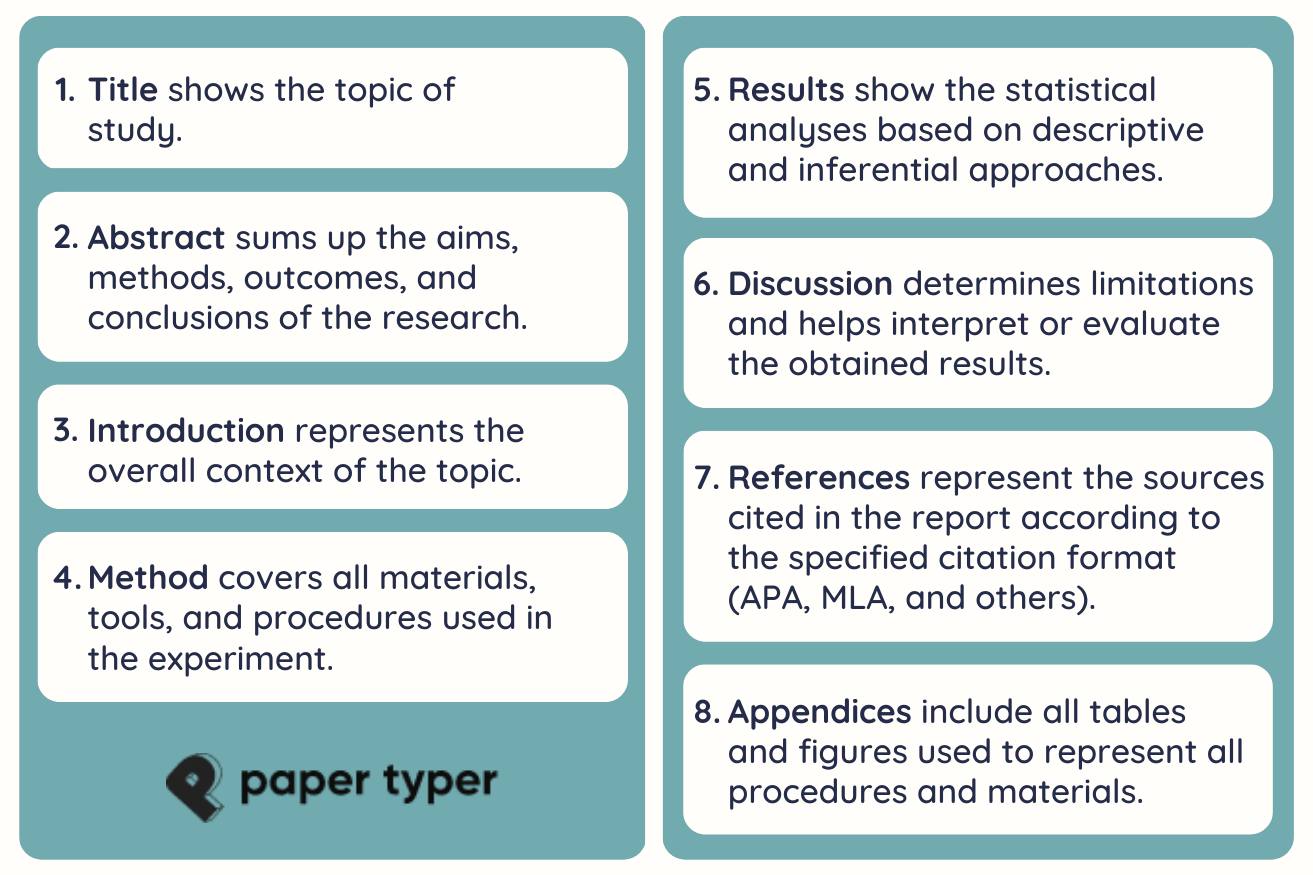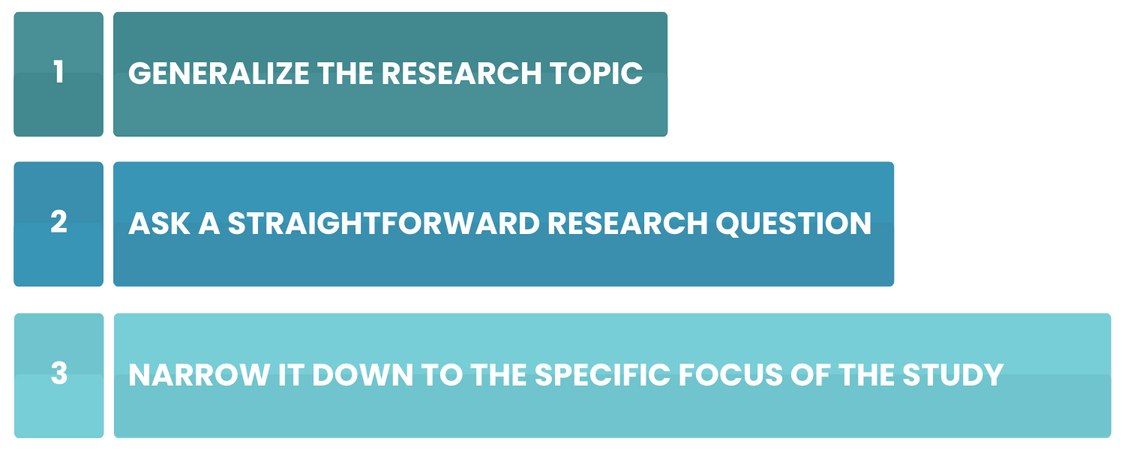How to Write a Lab Report
Table of contents
A specific kind of academic paper dedicated to the detailed description of a scientific experiment is called a lab report. It is devoted to conveying the aims, methods, results, and findings of some practical work in a specific field of study.
A lab report differs from a research paper because it is shorter. It is meant to express your understanding of practical forms of the scientific method application via the hands-on lab investigation.
Such reports are usually used in science, technology, engineering, and mathematics. These four fields are called STEM.
Let’s explain what parts a lab report should consist of and how to write them.
Entire Structure of a Lab Report
The main sections of a lab report can be different in various scientific fields because course requirements may differ a lot. However, the essential parts of it are the purpose, methods, and overall findings.
Each part of the report conveys certain ideas:

Some parts enlisted here can be omitted in certain kinds of reports. For example, it can be a conclusion.
Before writing a lab report, it is better to clarify the structure with your professor.
Title
The title creates the first impression of your report. It can transfer the topic and findings of the lab experiment.
The title should represent the main purpose or focus of the study. It should be informative. That is why do not make it too creative or complicated.
Abstract
This is a brief overview of your lab work. It can consist of 150-300 words but not more. This is a shortened version of the report describing in brief the aims, methods, and materials of the research. You also need to include the results and conclusions in it.
The abstract should provide a reader with a preview of the complete report. You should write it after you finish the entire report, in the past tense. It is essential because you need to see all the sections first and be able to explain what they are about.
You may use the following questions for writing an abstract:
- Explain a wider background and context of the study.
- What questions did your lab experiment answer?
- Which means and tools did you use to conduct the experiment?
- What kind of results did you obtain?
- Can you interpret these results clearly?
- Why are your findings important?
There may be some other questions to answer as well.
Introduction
The introduction should describe the background of your experiment. The funnel structure of the introduction is recommended. It is also called the inverted-triangle structure.

Provide consistent background information and show that your experiment is important in both practical and theoretical contexts. You can also briefly describe the previous research and show how your experiment may complement it.
Specify the details of the theoretical basis for your experiment. Describe what theories, rules, laws, or equations you have used. Introduce the aims of your research and your expectations to support your hypotheses.
The introduction should not be too long, but you may provide all the information in some paragraphs with subtitles, for example, ‘Research Aims’.
Method
This section explains in what way you have collected and analyzed the information. Provide specific details for your reader to be able to follow and assess all the procedures. This section is also in the past tense. Do not include any lengthy lists of procedures or materials. You should add them to the Appendices.
You have to explain the need for the subjects, experimental materials, and procedures for data analysis here.
Experimental Design
That can be of two main types - within-subjects and between-subjects. Explain in what way your experimental steps complied with the overall design.
Subjects
That can be the description of humans via demographic characteristics, or plants and animals via their genetic background. Indicate the overall number of subjects per one group or condition. Do not forget to mention how you picked out subjects for your study.
Materials
The lists of materials or equipment can be placed in the Appendices with the reference to them in this section. Be specific about the models of equipment. Try to provide a detailed description of all conditions and settings of the experiment. The labelled diagrams or images will work well here. Explain how you have controlled the extraneous variables, for instance, how you managed to keep up the stable temperature in the room.
Procedures
Here, you should describe the steps of the experiment in chronological order. The information should be consistent and enough for someone else to repeat the experiment. However, the description should be short and concise. If you need longer explanations, you can place them in appendices.
When conducting an experiment, you follow the procedure described in the lab manual. Your instructor may ask you to make a reference to this manual or describe other steps if you have decided to change them. There are also instructors who want you to rewrite everything said in the manual in your words and in complete sentences structured into paragraphs. You can also make notes of some steps you have changed.
The data analysis, if you perform it extensively, may require describing the analysis method. When you describe it, indicate which tests you had and what kind of software you have used.
Results
Here, you will represent the results of your statistical analysis. You need to analyze how these outcomes of your analysis possibly refute or support your initial statements or hypotheses.
This part can include:
- results of any statistical test;
- standard error or confidence intervals estimation;
- descriptive statistics;
- effects of the test results.
All the results are represented in text or charts and tables. You can also show relationships between different variables in graphs.
This section also includes sample calculations with clear and understandable symbols and a brief description. All the raw data should be shown in the appendices, so you need to refer to them while making comments on these sample calculations and highlighting the trends.
Discussion
This section is meant to show your critical thinking skills and your awareness of the main characteristics of the entire experimental process.
Here, you will:
- make comments on all the unexpected outcomes of the experiment;
- provide your interpretation of all results;
- determine the reasons for possible experimental errors;
- put forward further improvements for future experiments and studies;
- make a comparison of all the results with your initial expectations.
Remember!
Explain how the results of your experiment can answer the research question. Provide the information on whether you managed to support your hypotheses, measure everything you intended to, use the appropriate procedures for this type of experimental information. And whether the research findings are similar or different from the previous experiments’ results.
This section should also deal with strengths, weaknesses, and limitations of this study. Focus on their reliability and validity of the practical aspects of your study. Use examples to illustrate the limitations. For example, you can indicate the exact sources of the error and offer the ways for improvement.
Conclusion
This is the final part of your lab report. You need to sum up all the results and findings of the experiment as well as briefly overview the strengths and limitations. Provide your ideas and implications for possible further research.
Lab reports in some fields of study can omit the conclusion section because it repeats everything said in Discussion. However, you need to ask your professor about it.
Final Thoughts
Now, you know how to write the lab report and what parts it should consist of. Be sure to understand what you need to write about in every section because you should be as specific as possible. Do not make your lab report too lengthy and complicated. All the terms and findings used here should be consistently explained. Do not hesitate to ask questions to your instructors if you have doubts on what to write about in some sections.
You may need to look through this article again. Take time to do it and check whether you have included all the materials and data needed.You will succeed in your further studies if you manage to learn a lot about how to write academic paper of this kind.
